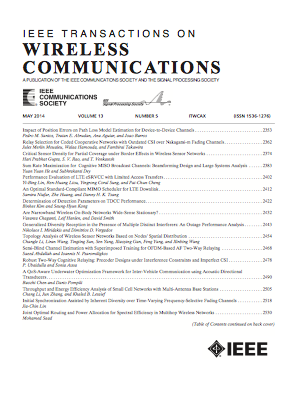Covert Communications Aided by Multi-Functional IRS: Energy Harvesting, Reflecting, and Amplifying
IF 10.7
1区 计算机科学
Q1 ENGINEERING, ELECTRICAL & ELECTRONIC
引用次数: 0
Abstract
The intelligent reflecting surface (IRS) has been widely applied in covert communications to hide the transmission behavior. However, the existing IRS relies on grid/battery power for its operation, which is unprocurable for practical covert communication applications. To address this issue, a novel multi-functional IRS (MF-IRS) is proposed for harvesting energy, signal reflecting, and amplifying simultaneously, where each element can flexibly switch between energy harvesting mode and passive/active reflection modes. To reveal the benefit of the MF-IRS for covert communications against multiple warders, the critical performance is analyzed, and effective design schemes are also provided. In particular, the detection error probabilities at warders are derived when the warders are non-collusive/collusive. In addition, the covert rate maximization problem is formulated by jointly optimizing the beamforming vector, element allocation matrices, and the reflection coefficient matrix. To solve this non-convex problem with highly coupled variables, an efficient successive convex approximation-based algorithm is proposed for the non-collusive scenario first and then extended to the collusive scenario. Simulation results demonstrate that the proposed MF-IRS always outperforms the self-sustainable passive/active IRSs, and it even outperforms the full-passive/active IRSs powered by grid/battery when the IRS is located near the signal source.由多功能IRS辅助的秘密通信:能量收集、反射和放大
智能反射面(IRS)被广泛应用于隐蔽通信中,以隐藏传输行为。然而,现有的IRS依靠电网/电池供电来运行,这对于实际的隐蔽通信应用来说是不可获得的。为了解决这一问题,提出了一种同时收集能量、反射和放大信号的新型多功能IRS (MF-IRS),其中每个元件可以灵活地在能量收集模式和被动/主动反射模式之间切换。为了揭示MF-IRS在对抗多个守卫的隐蔽通信中的优势,分析了其关键性能,并提供了有效的设计方案。特别地,推导了狱警是非串谋/串谋时狱警的检测错误概率。此外,通过联合优化波束形成矢量、单元分配矩阵和反射系数矩阵,提出了隐蔽速率最大化问题。为了解决高耦合变量的非凸问题,首先提出了一种高效的基于连续凸逼近的非串通场景算法,然后将其推广到串通场景。仿真结果表明,本文提出的红外红外系统始终优于自持续无源/有源红外系统,当红外红外系统位于信号源附近时,其性能甚至优于由电网/电池供电的全无源/有源红外系统。
本文章由计算机程序翻译,如有差异,请以英文原文为准。
求助全文
约1分钟内获得全文
求助全文
来源期刊
CiteScore
18.60
自引率
10.60%
发文量
708
审稿时长
5.6 months
期刊介绍:
The IEEE Transactions on Wireless Communications is a prestigious publication that showcases cutting-edge advancements in wireless communications. It welcomes both theoretical and practical contributions in various areas. The scope of the Transactions encompasses a wide range of topics, including modulation and coding, detection and estimation, propagation and channel characterization, and diversity techniques. The journal also emphasizes the physical and link layer communication aspects of network architectures and protocols.
The journal is open to papers on specific topics or non-traditional topics related to specific application areas. This includes simulation tools and methodologies, orthogonal frequency division multiplexing, MIMO systems, and wireless over optical technologies.
Overall, the IEEE Transactions on Wireless Communications serves as a platform for high-quality manuscripts that push the boundaries of wireless communications and contribute to advancements in the field.

 求助内容:
求助内容: 应助结果提醒方式:
应助结果提醒方式:


